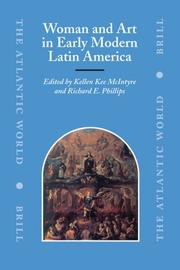| Listing 1 - 1 of 1 |
Sort by
|

ISBN: 9004153926 9786611400613 1281400610 9047410998 9789047410997 9789047410997 9789004153929 Year: 2007 Publisher: Leiden ; Boston : Brill,
Abstract | Keywords | Export | Availability | Bookmark
 Loading...
Loading...Choose an application
- Reference Manager
- EndNote
- RefWorks (Direct export to RefWorks)
This anthology centers on the visual representation of woman in early modern Latin America, that is, the social and cultural construction and definition of female identity as evidenced by the art document. Artists in this period were collectively aware of a vocabulary of gender that could be tailored to deliver varying messages about the position of women in vice regal culture and society. This volume is organized not in the predictable linear framework, by periods and centuries, but rather by the realization that throughout much of this period, Spanish authorities and others envisaged the Spanish colonies of the Americas in gendered terms. Proffered as the female body, the “New” (virginal by implication) World was at differing times adored, pursued, courted, seduced, defiled, exploited, reviled, and denounced by those (males) who encountered “her.” This mentality is born out in the various forms of female representation that are discussed in this fully illustrated book. Contributors include: C. Cody Barteet, María Elena Bernal-García, Magali M. Carrera, Carol E. Damian, Carolyn Dean, Catherine R. DiCesare, Lori Boornazian Diel, Kelly Donahue-Wallace, Ray Hernandez-Duran, Andrea Lepage, Kellen Kee McIntyre, Penny Morrill, Elizabeth Q. Perry, Richard E. Phillips, Michael J. Schreffler, and Christopher C. Wilson. ERRATUM TO CHAPTER 7 Ray Hernández-Durán, “ El Encuentro de Cortés y Moctezuma : The Betrothal of Two Worlds in Eighteenth-Century New Spain” (pp. 181–206). On page 194, second paragraph, third sentence, should read: “Marina’s absence in the encounter painting, where she normally mediates contact between the men, emphasizes the phallogocentric aspect of the historic meeting.” The original phrasing, using the pivotal term, ‘phallogocentric’ (a reference to a gendered form of exchange or communication) was changed to ‘phallus-centered,’ which not only alters a central idea in the argument, but actually has nothing to do with the image in question.
Women in art. --- Art, Latin American --- Art, Spanish American --- Latin American art --- Spanish influences.
| Listing 1 - 1 of 1 |
Sort by
|

 Search
Search Feedback
Feedback About
About Help
Help News
News